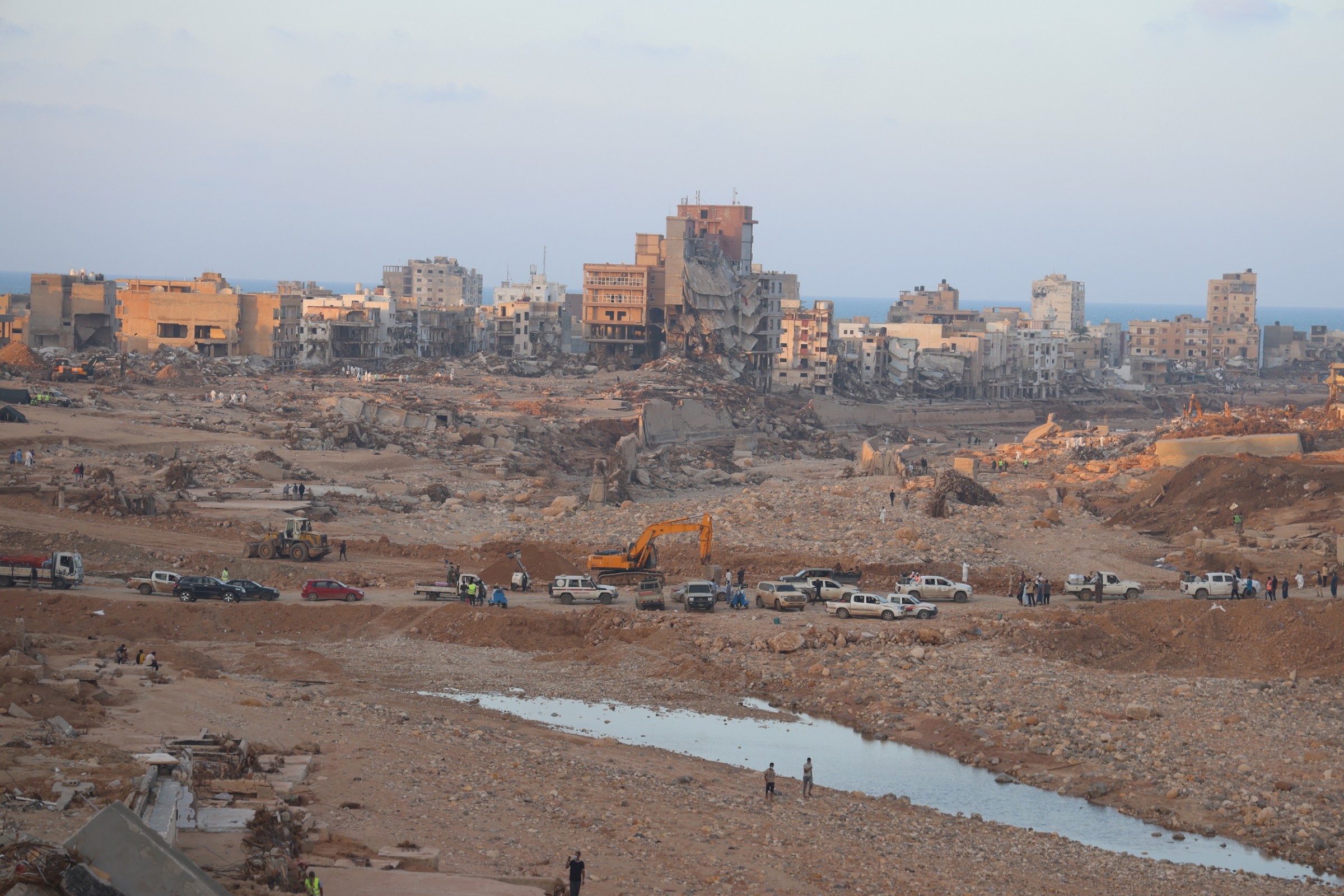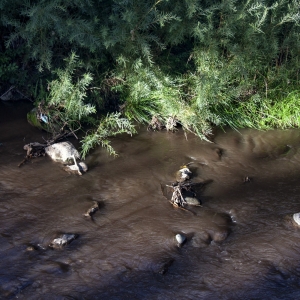The Stream, November 15, 2023: Slow Drought and Flash Floods Displace Thousands of Climate Refugees in Libya

On 16 September 2023, a convoy of cars and ambulance vehicles navigates through the devastated city center of Derna, in eastern Libya. In the background, the 350-year-old Alsahaba Mosque is visible while an excavator works to clear the rubble left behind by the flooding. Photo © UNICEF/UNI437442/Alatrib
YOUR GLOBAL RUNDOWN
- The rate of melting of Greenland’s glaciers has doubled over the past two decades.
- In Tokyo, mega-engineering projects designed to protect one of the world’s most densely populated cities from floods will be “put to the test” by climate change.
- Residents of Derna, Libya, a city already with thousands of refugees, are reckoning with another displacement as a result of drought, mismanaged dams, and Storm Daniel.
- Climate researchers have identified a “whiplash” effect that relates prolonged drought and heavy rains in northern Italy to weather patterns in Ethiopia and the Horn of Africa.
Millions of people in Somalia are forecasted to face extreme hunger as extreme drought, followed by record rains, have destroyed agricultural output.
“This bombardment of climate shocks, from drought to floods, will prolong the hunger crisis in Somalia. The drought killed millions of livestock and ruined countless hectares of pastures and farmlands. Now, these devastating floods are crippling Somalia’s ability to recover.” — Petroc Wilton, a World Food Programme spokesperson for Somalia.
The World Food Programme estimates that a quarter of Somalia’s population, some 4.3 million people, face “crisis-level hunger or worse” as a result of extreme climate fluctuations that have, over the past few months, dried out farmland before proceeding to drown it.
After months of drought throughout much of 2023, heavy rains began in October, Reuters reports. The extreme precipitation is responsible for at least 32 deaths, and more than 450,000 people have been forced from their homes.
— Christian Thorsberg, Interim Stream Editor
Recent WaterNews from Circle of Blue
- US Regulators Order Minnesota to Clean Up Nitrate Contaminated Water — EPA acts to limit an “imminent” health threat.
- EPA Restarts Assessment of Health Risks from Nitrate in Water — The agency will evaluate the hazards from agriculture’s primary water pollutant.
The Lead
Libya is home to nearly one million refugees, many from neighboring North African nations, who have fled violence and humanitarian or economic crises. Some lost their agricultural businesses as a result of prolonged drought in their home countries, and came to Libya hoping to rebuild their livelihoods. Some 8,000 people arrived in the eastern city of Derna.
But extreme weather has persisted in Libya, too, and worsened in recent months. Flash flooding caused by Storm Daniel — which “was up to 50 times more likely to occur and 50 percent more intense because of human-caused climate change, according to the World Weather Attribution group” — and failing dams have destroyed entire communities, Al Jazeera reports. The event last month coincided with a “slow” multi-year drought, a reminder of the haphazard pattern of precipitation climate change can cause.
As a result, some 40,000 people — now climate refugees — displaced by the floods have been forced to abandon their homes and move elsewhere.
Many people, who are now displaced for a second or third time, have trouble seeking asylum due to the vagueness of their refugee status as defined by international law. By 2050, some 1.2 billion people are estimated to be displaced, internally or externally, as a result of “intensifying climate weather events.”
“I experienced most wars and disasters, [Muammar] Gaddafi’s siege of the city in the 1990s, the ISIS [ISIL] war in 2016, and the war of [Khalifa] Haftar’s forces in 2018, but what happened now was different [and] what came after it was more humiliating,” Khadija, a climate refugee from Derna, told Al Jazeera.
This Week’s Top Water Stories, Told In Numbers
18
Percentage of their length that glaciers in southern Greenland have lost over the past 20 years due to melting, Yale Environment 360 reports. In the country’s north, glaciers have lost 10 percent of their length. New NOAA research indicates that the melting rate has doubled over the past 20 years.
7
Number of times per year, on average, that Tokyo’s flood tunnel system was activated from 2002 to 2019, Bloomberg reports. The massive, $2 billion underground space is built to withstand and divert “14 inches of rain within a 48-hour period,” an amount defined as a once-in-a-century flood. But climate change has left experts wary that greater levels of precipitation, with increased frequency, will continue to hit Tokyo and test its flood resilience infrastructure. In 2022, the government announced the Tokyo Resilience Project, a 15-trillion-yen plan to “fortify the capital’s infrastructure against natural and man-made disasters.”
On the Radar
The Guardian reports that extreme drought in northern Italy “has doubled over the past two decades,” a pattern that follows the experience of both Ethiopia and the Horn of Africa. The sudden changes — from periods of heavy rainfall to now worsening drought — are being described by researchers as “climate whiplash.” This “mix of both extremes” has also been felt in countries including Pakistan, Burkina Faso, Ghana, and Ethiopia. Experts warn that the trend complicates climate adaptation measures.
More Water News
Pink Pond: The pink color in a pond in Maui is likely caused by halobacteria, organisms that thrive in extremely salty water — a symptom of the island’s prolonged dry conditions, the New York Times reports.
‘Staggering’ Scarcity: According to a new report from the United Nations, 347 million children in South Asia are “exposed to high or extremely high water scarcity” as a result of climate change, Al Jazeera reports.
Christian Thorsberg is an environmental writer from Chicago. He is passionate about climate and cultural phenomena that often appear slow or invisible, and he examines these themes in his journalism, poetry, and fiction.







Leave a Reply
Want to join the discussion?Feel free to contribute!